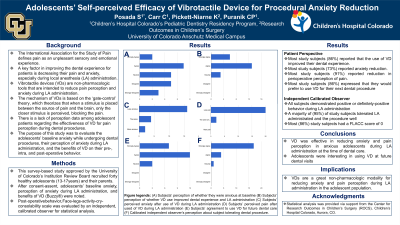Patient Management
399 - Adolescents’ Self-perceived Efficacy of Vibrotactile Device for Procedural Anxiety Reduction


Sara Posada, DDS
Dental Resident
Children's Hospital Colorado, Aurora, CO
Children's Hospital Colorado
Englewood, Colorado, United States- KP
Kaci Pickett-Nairne, M.S.
University of Colorado
- BC
Barbara C. Carr, D.D.S.
Children's Hospital Colorado
- CP
Chaitanya P. Puranik, B.D.S. M.S. M.Dent.Sci Ph.D. Diplomate
Children's Hospital Colorado

Chaitanya P. Puranik, BDS, MS, M.Dent.Sci, Ph.D.
Program Director
Children’s hospital Colorado
Children's Hospital Colorado and School of Dental Medicine, University of Colorado Anschutz Medical Campus
Aurora, Colorado, United States
Presenting Author(s)
Co-Author(s)
Program Director(s)
Purpose: The International Association for the Study of Pain (IASP) defines pain as an unpleasant sensory and emotional experience. Vibrotactile device (VD) is a non-pharmacologic tool that is intended to reduce pain and anxiety perception during local anesthetic (LA) administration. The VD mechanism is based on the ‘gate-control’ theory, which postulates that when a non-painful stimulus (vibration) is placed between the source of pain and the brain, only the non-painful stimulus is perceived by the brain. The purpose of this study was to evaluate the efficacy of VD for mitigating procedural anxiety and pain in adolescents.
Methods: This survey-based study was approved by the University of Colorado’s Institution Review Board. Survey participation was offered to forty healthy adolescents (13-17 years) and their parents reporting to Children’s Hospital Colorado’s Dental Clinic. After consent and assent, the adolescents’ anxiety before dental procedures, was evaluated. Study subject’s perception of anxiety during LA administration and benefits of VD were charted. Subjects’ post-operative behavior was evaluated by an independent, calibrated observer using the Face-legs-activity-cry-consolability scale. The data was subjected to statistical analysis.
Results: Most study subjects (61%) reported they were anxious about dental treatment pre-operatively. The majority (86%) of study subjects reported the use of VD improved their dental experience by reducing dental anxiety and perioperative pain perception. Most (86%) of the study subjects expressed that they would prefer to use VD for their next dental procedure.
Conclusion: VD was effective in reducing dental procedural anxiety and pain perception in anxious adolescents during LA administration.
Identify Supporting Agency and Grant Number: N/A

.jpg)